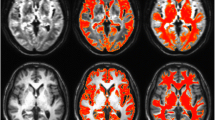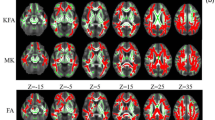Abstract
The first neuropathological alterations in Alzheimer’s disease (AD) occur in the medial temporal lobes (MTLs), in the entorhinal cortex (EC), perforant pathway (PP), and hippocampus. The purpose of this study was to investigate the microstructural integrity, size, and T 2-relaxation times of MTL structures in patients with AD and mild cognitive impairment (MCI), using MRI techniques that are immune to magnetic field inhomogeneities. Turboprop-DTI and high-resolution anatomical MRI data were obtained on AD and MCI patients, and healthy controls. Significant AD-related changes were detected in more MTL structures of AD patients by means of Turboprop-DTI than with any other technique used. Mean diffusivity and T 2-relaxation times of specific MTL structures increased in both the MCI and AD cohorts when compared to normal controls. Therefore, Turboprop-DTI and T 2-relaxometry may be valuable non-invasive tools in the investigation of the early AD-related neuropathological alterations.






Similar content being viewed by others
References
Arfanakis, K., Gui, M., & Lazar, M. (2005). White matter tractography by means of turboprop diffusion tensor imaging. Annals of the New York Academy of Sciences, 1064, 78–87.
Barnes, J., Scahill, R. I., Schott, J. M., Frost, C., Rossor, M. N., & Fox, N. C. (2005). Does Alzheimer’s disease affect hippocampal asymmetry? Evidence from a cross-sectional and longitudinal volumetric MRI study. Dementia and Geriatric Cognitive Disorders, 19, 338–344.
Basser, P. J., & Pierpaoli, C. (1996). Microstructural and physiological features of tissues elucidated by quantitative-diffusion-tensor MRI. Journal of Magnetic Resonance. Series B, 111, 209–219.
Benedict, R. H. B., Schretlen, D., Groniger, L., & Dobraski, M. (1996). Revision of the brief Visuospatial Memory test: Studies of normal performance, reliability, and validity. Psychological Assessment, 8, 145–153.
Bernasconi, N., Bernasconi, A., Andermann, F., Dubeau, F., & Reuters, D. C. (1999). Entorhinal cortex in temporal lobe epilepsy: A quantitative MRI study. Neurology, 52, 1870–1876.
Bozzali, M., Falini, A., Franceschi, M., Cereignani, M., Zuffi, M., Scotti, G., et al. (2002). White matter damage in Alzheimer’s disease assessed in vivo using diffusion tensor magnetic resonance imaging. Journal of Neurology, Neurosurgery and Psychiatry, 72, 742–746.
Braak, H., & Braak, E. (1997). Frequency of stages of Alzheimer-related lesions in different age categories. Neurobiology of Aging, 18, 351–357.
Bronge, L., Bogdanovic, N., & Wahlund, L. O. (2002). Postmortem MRI and histopathology of white matter changes in Alzheimer brains. A quantitative, comparative study. Dementia and Geriatric Cognitive Disorders, 13, 205–212.
Chetelat, G., & Baron, J. C. (2003). Early diagnosis of Alzheimer’s disease: Contribution of structural neuroimaging. NeuroImage, 18, 525–541.
Deibel, M. A., Ehmann, W. D., & Markesbery, W. R. (1996). Copper, iron, and zinc imbalances in severely degenerated brain regions in Alzheimer’s disease: Possible relation to oxidative stress. Journal of the Neurological Sciences, 143, 137–142.
Dickerson, B. C., Goncharova, I., Sullivan, M. P., Forchetti, C., Wilson, R. S., Bennett, D. A., et al. (2001). MRI-derived entorhinal and hippocampal atrophy in incipient and very mild Alzheimer’s disease. Neurobiology of Aging, 22, 747–754.
Evans, D. A., Funkenstein, H. H., Albert, M. S., Scherr, P. A., Cook, N. R., Chown, M. J., et al. (1989). Prevalence of Alzheimer’s disease in a community population of older persons: Higher than previously reported. JAMA, 262, 2552–2556.
Fellgiebel, A., Wille, P., Muller, M. J., Winterer, G., Scheurich, A., Vucurevic, G., et al. (2004). Ultrastructural hippocampal and white matter alterations in mild cognitive impairment: A diffusion tensor imaging study. Dementia and Geriatric Cognitive Disorders, 18, 101–108.
Folstein, M., Folstein, S., & McHugh, P. (1975). Mini-mental state. A practical method for grading the cognitive state of patients for the clinician. Journal of Psychiatric Research, 12, 189–198.
Gomez-Isla, T., Price, J. L., McKeel, D. W., Morris, J. C., Growdon, J. C., & Hyman, B. T. (1996). Profound loss of layer II entorhinal cortex neurons occurs in very mild Alzheimer’s disease. Journal of Neuroscience, 16, 4491–4500.
Han, X., Holtzman, D. M., McKeel, D. W., Jr., Kelley, J., & Morris, J. C. (2002). Substantial sulfatide deficiency and ceramide elevation in very early Alzheimer’s disease: Potential role in disease pathogenesis. Journal of Neurochemistry, 82, 809–818.
House, M. J., St. Pierre, T. G., Foster, J. K., Martins, R. N., Clarnette, R. (2006). Quantitative MR imaging R2 relaxometry in elderly participants reporting memory loss. AJNR American Journal of Neuroradiology, 27, 430–439.
Hyman, B. T., Van Hoesen, G. W., Kromer, L. J., & Damasio, A. R. (1986). Perforant pathway changes and the memory impairment of Alzheimer’s disease. Annals of Neurology, 20, 472–481.
Insausti, R., Juottonen, K., Soininen, H., Insausti, A. M., Partanen, K., Vainio, P., et al. (1998). MR volumetric analysis of the human entorhinal, perirhinal, and temporopolar cortices. AJNR American Journal of Neuroradiology, 19, 659–671.
Jenkinson, M., Bannister, P. R., Brady, J. M., & Smith, S. (2002). Improved optimisation for the robust and accurate linear registration and motion correction of brain images. NeuroImage, 17, 825–841.
Jezzard, P., & Balaban, R. S. (1995). Correction for geometric distortion in echo planar images from B0 field variations. Magnetic Resonance in Medicine, 34, 65–73.
Jezzard, P., Barnett, A. S., & Pierpaoli, C. (1998). Characterization of and correction for eddy current artifacts in echo planar diffusion imaging. Magnetic Resonance in Medicine, 39, 801–812.
Kalus, P., Slotboom, J., Gallinat, J., Mahlber, R., Cattapan-Ludewig, K., Wiest, R., et al. (2006). Examining the gateway to the limbic system with diffusion tensor imaging: The perforant pathway in dementia. NeuroImage, 30, 713–720.
Kaplan, E., Goodglass, J., & Weintraub, S. (1983). Boston naming test. Philadelphia: Lea and Febiger.
Killiany, R. J., Hyman, B. T., Gomez-Isla, T., Moss, M. B., Kikinis, R., Jolesz, F., et al. (2002). MRI measures of entorhinal cortex vs hippocampus in preclinical AD. Neurology, 58, 1188–1196.
Laakso, M. P., Partanen, K., Soininen, H., Lehtovirta, M., Hallikainen, M., Hanninen, T., et al. (1996). MR T2 relaxometry in Alzheimer’s disease and age-associated memory impairment. Neurobiology of Aging, 17, 535–540.
Le Bihan, D., Mangin, J. F., Poupon, C., Clark, C. A., Pappata, S., Molko, N., et al. (2001). Diffusion tensor imaging: Concepts and applications. Journal of Magnetic Resonance Imaging, 13, 534–546.
McKhann, G., Drachman, D., Folstein, M., Katzman, R., Price, D., Stadlan, E. M., et al. (1984). Clinical diagnosis of Alzheimer’s disease: Report of the NINCDS-ADRDA work group under the auspices of the Department of Health and Human Services Task Force on Alzheimer’s disease. Neurology, 34, 939–944.
Muller, M. J., Greverus, D., Dellani, P. R., Weibrich, C., Wille, P. R., Scheurich, A., et al. (2005). Functional implications of hippocampal volume and diffusivity in mild cognitive impairment. NeuroImage, 28, 1033–1042.
Muller, M. J., Mazanek, M., Weibrich, C., Dellani, P. R., Stoeter, P., & Fellgiebel, A. (2006). Distribution characteristics, reproducibility, and precision of region of interest-based hippocampal diffusion tensor imaging measures. AJNR American Journal of Neuroradiology, 27, 440–446.
Pennanen, C., Kivipelto, M., Tuomainen, S., Hartikainen, P., Hanninen, P., Laakso, M. P., et al. (2004). Hippocampus and entorhinal cortex in mild cognitive impairment and early AD. Neurobiology of Aging, 25, 303–310.
Petersen, R. C., Stevens, J. C., Ganguli, M., Tangalos, E. G., Cummings, J. L., DeKosky, S. T., et al. (2001). Practice parameter: Early detection of dementia: Mild cognitive impairment (an evidence-based review): Report of the quality standards subcommittee of the American Academy of Neurology. Neurology, 56, 1133–1142.
Pipe, J. G., & Zwart, N. (2006). Turboprop: Improved PROPELLER imaging. Magnetic Resonance in Medicine, 55, 380–385.
Pruessner, J. C., Li, L. M., Serles, W., Pruessner, M., Collins, D. L., Kabani N., et al. (2000). Volumetry of hippocampus and amygdala with high-resolution MRI and three-dimensional analysis software: Minimizing the discrepancies between laboratories. Cerebral Cortex, 10, 433–442.
Reitan, R. M. (1958). Validity of the trail making test as an indication of organic brain damage. Perceptual and Motor Skills, 8, 271–276.
Rose, S. E., McMahon, K. L., Janke, A. L., O’Dowd, B., de Zubicaray, G., Strudwick, M. W., et al. (2006). MRI diffusion indices and neuropsychological performance in amnestic mild cognitive impairment. Journal of Neurology, Neurosurgery and Psychiatry, 77, 1122–1128.
Shapiro, A. M., Benedict, R. H., Schretlen, D., & Brandt, J. (1999). Construct and concurrent validity of the Hopkins Verbal Learning Test revised. Clinical Neuropsychology, 13, 348–358.
Spreen, O., & Strauss, E. (1998). Controlled oral word association. A compendium of neuropsychological tests (2nd ed., pp. 447–464). New York: Oxford University Press.
Takahashi, S., Yonezawa, H., Takahashi, J., Kudo, M., Inoue, T., Tohgi, H. (2002). Selective reduction of diffusion anisotropy in white matter of Alzheimer disease brains measured by 3.0 Tesla magnetic resonance imaging. Neuroscience Letters, 332, 45–48.
US Congress Office of Technology Assessment (1987). Losing a million minds: Confronting the tragedy of Alzheimer’s disease and other dementias. U.S. Government Printing Office, p. 14.
Wang, H., Yuan, H., Shu, L., Xie, J., & Zhang, D. (2004). Prolongation of T2 relaxation times of hippocampus and amygdala in Alzheimer’s disease. Neuroscience Letters, 363, 150–153.
Wilkinson, G. S. (1993). The wide range achievement test- III. Wimnington, DE: Jastack Associates, A division of Wide Range Inc.
Witter, M. P., Wouterlood, F. G., Naber, P. A., & van Haeften, T. (2000). Anatomical organization of the parahippocampal–hippocampal network. Annals of the New York Academy of Sciences, 911, 1–24.
Wolf, H., Hensel, A., Kruggel, F., Reidel-Heller, S., Arendt, T., Wahlund, L., et al. (2004). Structural correlates of mild cognitive impairment. Neurobiology of Aging, 25, 913–924.
Yesavage, J. A., Brink, T. L., Rose, T. L., & Adey, M. (1983). The geriatric depression rating scale: Comparison with other self-report and psychiatric rating scales. In T. Crook, S. Ferris, & R. Bartus (Ed.), Assessment in geriatric psychopharmacology (pp. 153–167). New Canaan, CT: Mark Powley.
Zola-Morgan, S., Squire, L. R., & Ramus, S. J. (1994). Severity of memory impairment in monkeys as a function of locus and extent of damage within the medial temporal lobe memory system. Hippocampus, 4, 483–495.
Acknowledgements
This work was supported in part by a grant from the Alzheimer’s Association to Dr Arfanakis. JDC is partially supported by Emory University. The authors would like to thank Drs A. Solodkin and J. Mastrianni for recruitment of patients.
Author information
Authors and Affiliations
Corresponding author
Rights and permissions
About this article
Cite this article
Arfanakis, K., Gui, M., Tamhane, A.A. et al. Investigating the Medial Temporal Lobe in Alzheimer’s Disease and Mild Cognitive Impairment, with Turboprop Diffusion Tensor Imaging, MRI-volumetry, and T 2-relaxometry. Brain Imaging and Behavior 1, 11–21 (2007). https://doi.org/10.1007/s11682-007-9001-4
Published:
Issue Date:
DOI: https://doi.org/10.1007/s11682-007-9001-4




